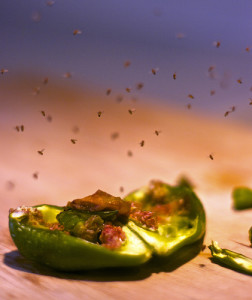Other Sources for Fruit Flies Besides Fruit
By Chris Williams on December 11, 2014.
I think I saw one of your earlier blogs that mentioned places where fruit flies breed besides in fruit. Could you repeat that information because we have a chronic fruit fly problem in our beauty salon and no fruit anywhere around? Thank you. A.D., Sterling, MA
 Yes, fruit fly larvae can be found developing in places where there is an accumulation of fermenting, rotting, or scummy liquid or food residues such as:
Yes, fruit fly larvae can be found developing in places where there is an accumulation of fermenting, rotting, or scummy liquid or food residues such as:
- Vegetable or fruit bins – Check for rotten apples, potatoes, tomatoes, etc. stored in bins or bags.
- Fruit and vegetable scraps – Look for spills under appliances and counters.
- Empty bottles and cans – Fruit flies can breed in the residue of “empty” returnable or discarded wine, beer, milk, ketchup, and other bottles, or in the liquid left in empty soda cans.
- Beer or wine dispensers – Fermenting residues in a drain or from spills are prime breeding sites.
- Dumbwaiter pit – These pits are rarely cleaned adequately and may be loaded with rotting food.
- Garbage cans – Food scraps and sticky residues should be removed by periodic washing. Check under the can liner.
- Cleaning water runoff – Mopping and cleaning water can carry food “goo” under walls and into cracks in broken tile and damaged grout.
- Utility sink – An incrustation of food can build up on a sink used as a common drain for mop basins, dishwashers, potato-peeling machines, etc.
- Traps and drains – Check for leaking grease traps and broken or stagnant floor drains.
- Dishcloths and mops – Old, forgotten dishcloths, mops, towels, and rags can sour and ferment and breed flies.
- Food or beverage carts – Food scraps and sticky residues should be removed by aggressive washing.
For more help on finding and eliminating fruit flies, give Colonial Pest a call, and check out these related blogs:
- Why Do I Get Fruit Flies Every Summer?
- Fruit Flies Come From Many Sources
- Finding the Source of Fruit Flies
- The Pests May Not Be Fruit Flies
Photo credit: Alejandro Erickson / Foter / CC BY
Sign up for our biweekly email newsletter for more information about bugs and pests!